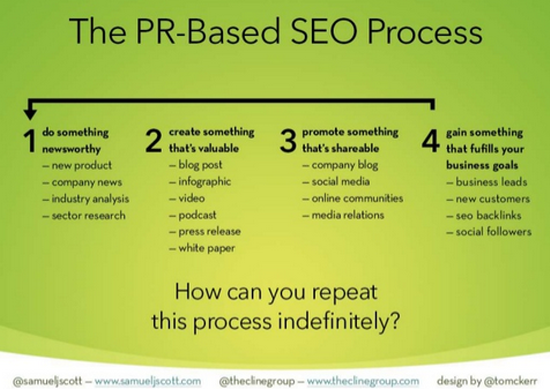How to effectively integrate SEO into your business and marketing
Search engine optimisation (SEO), content marketing, social media and public relations (PR) have previously been treated as separate compartments. The different departments, agencies or consultants would rarely collaborate which lead to many missed opportunities.
But the times, they are a-changin’. And so is the way you’re doing business online.
It doesn’t matter if you run a clothing shop, a small plumbing business or a bakery. If you don’t integrate SEO into your other marketing channels and seize all opportunities to grow your business, you might as well put up your “going out of business, everything must go” sign right now.
In today’s post we’ll talk about why your strategy shouldn’t be about including SEO, social media and PR in your business and marketing but about intelligently integrating them all in a manner that helps you to dominate your niche. By doing this you will able to achieve long-lasting results, increase sales and grow your business.
To make this post easier to go through, we’ve structured it into six sections:
- Social media
- Content marketing
- Email marketing
- Public relations
- Affiliate marketing
- User experience
Lots of information to go through to let’s get started.
1. SEO and social media

While Google’s Matt Cutts has denied social signals are used as a ranking factor, that doesn’t make social media less important. Ok, so it doesn’t have a direct impact on organic search rankings, but it does help SEO indirectly.
Think about it. The billions of active users on Facebook, Twitter, Google+, YouTube, Instagram as well as on various review sites and discussion forums are your current and potential customers.
Although social shares may or may not affect a webpage’s position in search listings, your social profiles definitely influence the content of your search results. In fact, social media profiles are often among the top results in search listings for brand names. What people say about your business on Facebook, Yelp, TripAdvisor – whether it’s feedback in the form of a comment or a rating – is publicly accessible to your potential customers. And this, of course, influences their decision to buy from you or from your competitors.
Social media also helps to build trust, which is something that Google is looking for in a website.
Today, people no longer trust everything they see or hear which is why they’re constantly looking for social proof and validation of their choice. When you integrate your most important keywords into your social marketing campaigns, your audience will use those terms to research your business. When they find you at the top of Google’s search results and see other mentions of your brand (for example, on social media platforms, review sites, forums and more)… they begin to trust you.
What you need to understand is that Google is always watching. Whatever you or your fans and followers post on social media affects how Google sees your brand and, in turn, affects your rankings in local search results.
Now, let’s take a look at six of the best practices for incorporating SEO into your social efforts:
- Focus on “people building” instead of link building. Build a network of fans and followers who are active on social media and willing to spread the word about your brand and your offering.
- Create and publish useful, fascinating content that people will want to read and share. Being mediocre will get you nowhere.
- Get people to engage and encourage them to recommend you. When your business name is mentioned this attracts search engines’ attention. Here are a few ideas on how to attract more reviews from customers.
- Optimise the meta data on your web pages correctly. This ensures that when someone shares one of your pages on Twitter or Facebook, the snippet that appears is catchy and attracts even more clicks. To learn how to do this, read the “Back to the basics: Optimising your meta tags for SEO and CTR” section in this article.
- Make your content easy to share. Add social buttons on your site and blog to allow people to quickly and easily share or rate your content directly from your website. You can also use social snippets to ensure your pages display an attractive preview when shared on social media. Learn how in this guide. This helps to build buzz and attention around your site.
- Optimise your Google My Business listing as this is critical for getting you to perform well in local search results. Check out our beginner’s guide to local SEO to learn how to properly implement local SEO and guide customers to your door step.
- Analyse and learn how to get better. Look at your analytics to determine how well you’re performing on social media and see where there is room for improvement.
Don’t forget to also check out our complete Social Media Guide to find out how to use and make the most of the top social media platforms on the web.
2. SEO and content marketing
If Google’s Hummingbird and RankBrain algorithms have taught us anything – it’s that every piece of content that you create needs to provide value to your audience.
Writing unique, high-quality, useful, interesting content is the best way to get people to recommend or link to your content. It also helps you to build trust and to become an authority in your niche. It’s also the only way to rank well and to survive future algorithm updates.
Now, SEO and content marketing need to work together to boost your search marketing efforts so don’t make the mistake of choosing one over the other because:
- If you choose to just create awesome content without doing any SEO, no one will be able to find your content. And if they can’t find it, they can’t share it or engage with it.
- If you spend lots of time on SEO and not so much on content, you’ll stand no chance at building a relationship with your audience.
So what you must understand is that SEO and content marketing need to work together, as one feeds off the other.
Here is how to integrate SEO into your content marketing:
- Create unique, high-quality content. It’s what sets you apart from the crowd and what gets people to read and share your content. Plus, Google loves fresh and unique content so give it what it wants.
- Create content that your audience is interested in. Find out more about your audience, learn what their problems, needs and wants are as well as what keywords and phrases they use to search for you online. Based on all this information you can start creating content that they will find useful or interesting. Check out our guides on how to use Google Search Console and Google Analytics to find out more about your audience and what terms they use to get to your site.
- Optimise your content for SEO. Optimise it with the correct keywords that are relevant to the content on that page. You should also link to it from older pages or blog posts (obviously these need to be relevant) to pass on some of the ‘link juice’. Don’t forget to also optimise your meta data as it’s what users see in search engine results when they search for your brand or your products. You want to make sure that they attract clicks.
Additional resources:
Hummingbird: A wake-up call for better content marketing
SEO for content marketing: seven success factors
3. SEO and email marketing
Google’s spiders aren’t crawling through the emails you’re sending to your customers. However, that doesn’t mean you can’t use them to beef up your SEO.
Email is a great way to boost engagement.
Say you’re a small HR recruiting firm and you’ve published a fantastic blog post with tips to boost employee retention. Since you have companies in your subscribers list that might find it useful, you send them an email and encourage them to try those strategies to motivate more employees to stick around.
The results? Some good traffic to your site and, depending on how great the post is, maybe even some shares, tweets and comments on your blog post.
You can go even further and include social icons in your email to encourage readers to connect with you on various social media channels. This gives you more opportunities to share other content and maybe turn them into customers or brand advocates later on.
Here are a few ways to integrate SEO into your email marketing:
- Optimise your subject line. While your subject line needs to pique readers’ interest and get them to click, try to include a keyword that’s relevant to the content inside the email. This accomplishes two things: 1. It gives readers an idea of what’s inside and 2. If someone archives your email or moves it into a “Read later” folder, they can easily find it later on by simply running a search that contains that keyword.
- Optimise your call-to-action (CTA) copy. The anchor text on your call-to-action links is also important. So, don’t use the boring “click here” or “find out more”. Be more specific by using a CTA like “Learn how to boost employee retention”.
- Archive your emails. Never delete your email newsletters. Instead, create an email archive and put it in a special section on your site so other people can find it. This allows you to pick up new email subscribers from searches.
4. SEO and PR
You already know by now just how important it is to write unique, high-quality, interesting content. However, what’s just as important is knowing how to promote it. And this is where public relations comes in.
PR professionals are insanely valuable to your SEO efforts because they know:
- How to build relationships with influencers, journalists, and bloggers. They know how to work with people.
- How to pitch content. They have tricks up their sleeves that can help them get a piece of content published so it reaches your target audience.
- What journalists, bloggers and news outlets are looking for.
They also know that it’s not all about links.
Sure, links are still important but the point is to first build a brand, gain exposure, and second to get referral traffic via a link. So it’s not directly about links but about getting coverage. The links will come later on.
Samuel Scott, Senior Director of SEO and Digital Marketing for The Cline Group, explains how to use online PR to get coverage and improve SEO in a process he calls the PR-based SEO process:
So the process has three steps:
- Do something newsworthy. (Release a new product or feature, hire a big-time executive, conduct an analysis of the state of the industry)
- Create newsworthy content based on what has been done. (It can take any form: a blog post, an infographic, a video, a podcast)
- Promote the company and content using online PR and social media. This helps you get coverage, brand mentions and backlinks, which obviously helps your SEO.
If you want a more detailed guide that explains the step-by-step process of PR and SEO integration, the same Samuel Scott has created a very useful infographic that details the process. Make sure you check it out on the the Moz Blog.
Additional resources:
Blurred lines: How PR and SEO are holding hands
Integrating public relations with SEO strategies
5. SEO and affiliate marketing
It doesn’t matter what you’re selling, if you’re creating a site that doesn’t add any value and it’s there just to make money, it won’t ever succeed.
As with any other website, affiliate sites need to provide valuable content – blog posts, guide and infographics – and find effective ways to market it to the right audience.
Now, if you’re a business offering affiliate programmes, here are some ideas that can help you optimise your own affiliate programme:
- Make sure affiliates are linking to the correct pages. If you make changes to your URL structure, make sure you implement redirects correctly. Otherwise your affiliates will link to your old pages which will result in 404 not found pages.
- Help your affiliates create unique and valuable content. Provide them with guides and tutorials so they can make the most of their website.
- Make sure affiliates use the rel=nofollow atribute when linking to you as Google views these as paid links.
For more tips on how to get SEO value from your affiliate links, check out this article from the Moz Blog. You might also find this Q&A on affiliate programs and SEO useful.
6. SEO and user experience
Many site owners are obsessed with ranking highly for specific keywords and getting as much traffic to their site as possible. But there’s one very important thing they’re not focusing on but should: what visitors will do once they get on their site.
You may have awesome copy on your website that’s also optimised for the right keywords. You may also have your meta data in place. But that’s worth nothing if, when visitors land on your site, they:
- Get confused
- Can’t find their way around or
- Are forced to fill out a long form with about 20 questions.
You need to think about the entire customer journey and this means good user experience (UX) and good SEO.
A site that loads quickly, is well organised and searchable will be more enjoyable for users. This results in your visitors spending more time on the site, visiting more pages and hopefully buying more.
Plus, your bounce rate will also decrease as your site becomes more engaging which will make your site rank higher in search engine results.
Here are a few questions that you need to ask yourself to ensure that you’re not only making it easy for your audience to find you online but also that you’re providing them with a great experience on your site:
- Do your website’s pages load in a reasonable amount of time? If it takes more than ten seconds for a page to load, most users will leave your site. So, make sure you test your site speed and improve it if necessary as page speed is linked better rankings and user engagement.
- How easily can users (and search engine bots) find their way around your site? Is the navigation confusing?
- Is the content easy to read?
- Is the colour scheme easy on the eyes?
Make sure you also read this guide on the impact of usability and user experience on search engine rankings.
Wrapping up
The most important thing you need to remember is that it’s all about the user. So your job is to optimise for the destination. This means that SEO needs to be integrated with everything from web design and development to content marketing, social media and PR.
It’s the only way to get SEO to really work for you.
Are you integrating SEO into your marketing? Got any tips you’d like to share with us?



